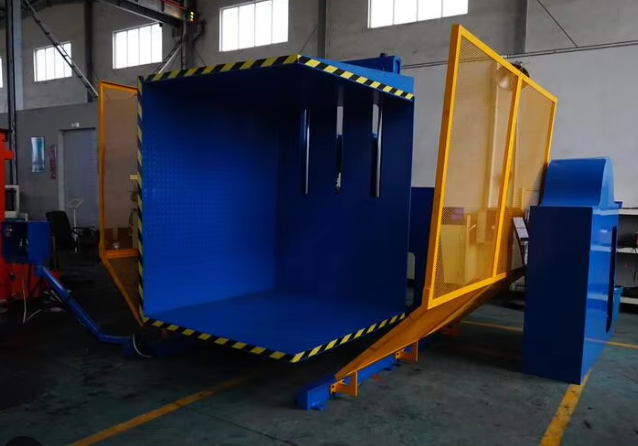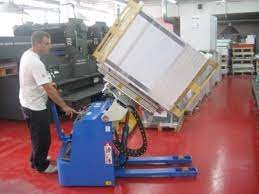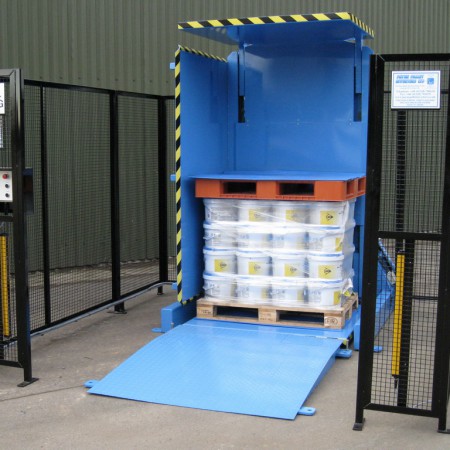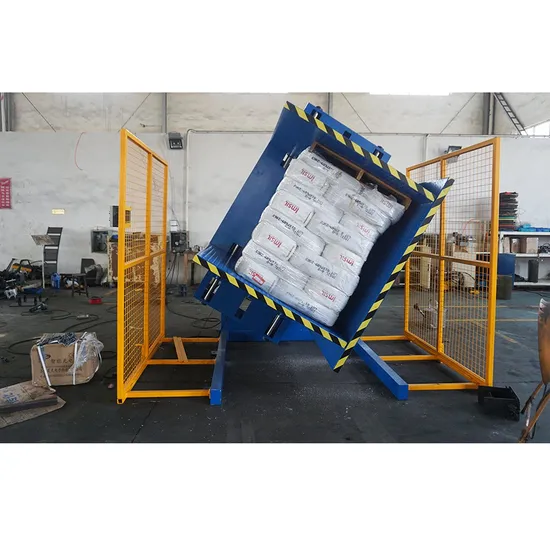Choosing the Right Pallet Inverter for Italy's Demands in Ergonomic Handling in Boutique Production Plants
Your production line is under constant pressure. You need to move goods with speed and precision, but manual handling is a bottleneck. It is slow, it is risky, and it is expensive. Every time an employee manually re-stacks a pallet, you are risking back injuries, which lead to downtime and compensation claims. You are also risking product damage from drops or mishandling, which disappoints customers and hurts your hard-won reputation. This problem only gets worse as your equipment ages and safety regulations become stricter. A pallet inverter is not just another piece of machinery. It is a strategic tool that automates a difficult process, protects your employees, secures your product, and boosts your bottom line.
Choosing the right pallet inverter for demanding environments, like those found in Italy's specialized boutique production plants, requires a focus on three key areas. You need robust construction to handle specific load types. You need advanced safety features to meet stringent ergonomic standards. And you need flexible controls to integrate seamlessly into a smart, digitalized workflow. This approach ensures not just compliance, but a significant return on investment through improved efficiency and reduced operational costs.

I know what you might be thinking. "A pallet inverter? Is that really a priority for my operation?" I have seen this hesitation many times. But over my decades in this industry, from my start as an engineer on the factory floor to owning my own successful plant, I have learned a critical lesson. The smartest investments are often in the places you least expect. Let's break down why this piece of equipment is more than just a convenience. It is a cornerstone of modern, efficient production, whether you're running a small workshop or a massive industrial facility.
Why is ergonomic handling a critical investment, even for heavy industries?
You see the line items on your balance sheet for workplace injuries and operational inefficiencies. They are a constant drain on your resources. You might even accept them as a normal cost of doing business in a demanding industry. But these are not just numbers on a page. An injured worker means a skilled and trusted team member is out of action, causing production to slow and team morale to drop. Simple manual handling errors lead to damaged goods that you must scrap or sell at a discount. These small, daily losses add up to a significant impact on your annual profit margin. You are fighting to lower overall costs, but this hidden expense is always working against you. Investing in ergonomic handling equipment like a pallet inverter directly attacks these hidden costs. This is not about being soft; it is about being smart. It protects your most valuable asset—your people—and in doing so, it protects your production schedule, your product quality, and your profitability.
Ergonomic handling is a critical investment because it directly reduces two of the biggest operational drains: labor costs from injuries and material losses from damage. By automating the heavy, repetitive, and awkward task of turning or transferring pallet loads, a pallet inverter improves worker safety, increases throughput, and ensures product integrity. This delivers a clear and measurable return on investment that you can see in your bottom line.

Diving Deeper into Ergonomics and ROI
I have seen firsthand how focusing on ergonomics translates directly to financial gains. It's a simple equation: a safer worker is a more productive worker, and a secure process is a more profitable one. Let's look at this from a practical, business-owner perspective.
First, consider worker safety. Manual pallet handling is a leading cause of musculoskeletal injuries in industrial settings. These injuries are not just painful for the employee; they are incredibly expensive for the company.
| Risk of Manual Handling | Direct & Indirect Costs | The Ergonomic Solution |
|---|---|---|
| Lifting heavy loads (25kg+) | Medical bills, insurance premium increases | A pallet inverter automates the entire lifting and turning process. |
| Repetitive twisting motions | Lost workdays, cost of hiring temporary staff | The machine smoothly rotates the load 90 or 180 degrees. |
| Awkward postures | Lowered morale, administrative time on claims | The load is presented at an optimal height for the operator. |
When I established my own factory, one of my first principles was to engineer out the most physically demanding tasks. The result was not just a better safety record, but higher morale and lower employee turnover. People want to work where they feel safe and valued.
Next, let's talk about product integrity. This is especially crucial in specialized markets, like the boutique producers in Italy, but the principle is universal. Manual handling is inconsistent. A tired worker might set a pallet down too hard. An unstable stack could shift and cause products to crush each other. A pallet inverter handles every load with the same precise, controlled pressure and smooth motion. Whether you are handling fragile glass bottles, sensitive electronics, or even heavy, scratch-prone steel components, the machine eliminates the human variable that leads to damage. This reduces your scrap rate and ensures the quality your customers expect.
Finally, there is operational efficiency. A task that might take two workers 15 minutes to complete manually—destacking, transferring, and restacking a pallet—can be done by a pallet inverter with one operator in about 60 seconds. Think about that. That's a 90% reduction in time and a 50% reduction in labor for that specific task. If your line handles 50 pallets a day, you are saving over 12 man-hours every single day. That time and labor can be reallocated to more value-added activities. This is how you increase throughput without increasing headcount. It is a direct and powerful way to boost your plant's overall productivity.
What specific features should a pallet inverter have for demanding production environments?
You have decided to explore getting a pallet inverter, but you find the market is flooded with options. On the surface, many of them look the same. A cheaper machine from an unknown brand might seem tempting as a way to save on initial capital outlay. But I know from hard experience that a poor equipment choice can create years of expensive headaches. Choosing the wrong machine often leads to constant breakdowns, which can stop your entire production line. It might not be built to handle your specific product weight or dimensions, leading to product damage or even catastrophic failure. Or worse, it could be unsafe, putting your operators at serious risk and failing to meet the very ergonomic goals you set out to achieve. The initial savings are quickly erased by spiraling maintenance costs, lost production hours, and a frustrated team.
For a demanding production environment, whether it is a high-end Italian plant or a massive steel mill, a pallet inverter must have specific features. You must look beyond the price tag. Focus on the core build quality, the flexibility of the control system, and the robustness of its safety mechanisms. These are the critical details that define a strategic asset versus a future problem on your factory floor.

Diving Deeper into Essential Machine Features
As an engineer, I love getting into the technical details. These details are what separate a machine that lasts for 15 years from one that becomes a problem in 15 months. Let's break down what you need to scrutinize.
Build Quality and Durability
This is the foundation of a reliable machine. It's something you can often see and feel. Ask the supplier about the thickness of the steel used in the frame. How are the welds? Are they clean and continuous, or are they spotty? A heavy-duty frame is essential to handle the dynamic forces of rotating a multi-ton load day after day without flexing or fatigue.
Then, look inside at the components. These are the heart and lungs of your machine.
- Drive System: Is it hydraulic or electric? A robust hydraulic system with high-quality pumps and hoses from a reputable brand provides immense power and reliability. An all-electric system can offer cleaner operation and precise control. The key is to ensure the motors and gearboxes are from world-class manufacturers like Siemens, SEW-Eurodrive, or a comparable industry leader.
- Bearings and Bushings: These are wear parts, but high-quality ones last significantly longer. Ask about the brand and the load rating. This is where cheap machines cut corners first.
I always tell my clients, "Pay for good steel and good components now, or you will pay for it ten times over in downtime later." It's a lesson I learned the hard way.
Control System and Integration
This is where a pallet inverter evolves from a simple machine into a smart factory asset. It is a critical area for anyone focused on digitalization.
| Feature | Basic Control System | Advanced (MES-Ready) Control System |
|---|---|---|
| Interface | Physical push-buttons | Color touchscreen HMI (Human-Machine Interface) |
| Operation | Manual sequence, one-size-fits-all | Stored recipes for different pallet/product types |
| Flexibility | Fixed clamping pressure | Adjustable pressure control from HMI to prevent damage |
| Connectivity | None. It's an isolated machine. | Ethernet port for connection to MES/SCADA systems |
| Data | No data output | Provides cycle times, fault codes, motor current data |
An advanced control system allows you to integrate the pallet inverter directly into your plant's digital ecosystem. This is no longer just a "nice to have" feature; it is essential for modern manufacturing.
Versatility and Safety
Your products are not all the same, so your machine shouldn't be a one-trick pony. Look for adjustable side walls to secure loads of different widths. The ability to control clamping pressure is non-negotiable for handling a mix of robust and delicate goods. You need to be able to invert a pallet of steel parts and then, with a simple recipe change, handle a pallet of finished goods in cardboard boxes without crushing them.
Finally, safety cannot be an afterthought. Comprehensive safety features are a must. This includes light curtains that stop the machine instantly if an operator enters the area, physical safety fencing, and emergency-stop buttons that are easily accessible from all sides. A machine that meets or exceeds international safety standards (like CE for Europe) is a clear sign of a quality manufacturer.
How does a pallet inverter contribute to digitalization and lower operational costs?
Your company goals are clear and ambitious. You want to embrace digitalization to get a better handle on your processes. You need to cut overall operational costs by a significant margin, perhaps as much as 8%. But it can be difficult to see how a single piece of equipment, like a pallet inverter, fits into that massive big-picture strategy. You might see it as just a mechanical tool, a standalone machine that is disconnected from your new MES platform or your big data initiatives. If the machine cannot "talk" to your other systems, it remains an island of inefficiency. You are left guessing about its actual performance, its real-time status, and its true contribution to your production flow. This gap between your new digital strategy and your old analog equipment is a source of constant frustration.
A modern pallet inverter is not just a mechanical tool. It is a data-rich node in your smart factory ecosystem. When you choose the right machine with the right controls, it feeds crucial, actionable information directly into your digital platforms. This gives you the visibility you need to optimize your processes, predict maintenance needs, and prove its direct contribution to lowering your operational costs.

Diving Deeper into Data and Cost Reduction
Let's get specific about how this single machine becomes a powerful tool for achieving your highest-level business goals. It acts as a bridge between the physical world of your factory floor and the digital world of your control systems.
The Bridge to Digitalization
A smart pallet inverter is equipped with sensors that are the eyes and ears of your digital strategy. These sensors track key performance indicators (KPIs) in real-time.
- Cycle Count and Time: The PLC tracks every cycle. This data, sent to your MES, tells you exactly how much the machine is being used. You can compare its throughput against your production schedule to identify bottlenecks or excess capacity.
- Motor Current and Hydraulic Pressure: These are not just operational metrics; they are powerful indicators of machine health. A gradual increase in motor current might signal that a bearing is beginning to fail. A drop in hydraulic pressure could indicate a small, developing leak.
- Fault Codes: When the machine stops, it shouldn't be a mystery. A smart inverter sends a specific fault code (e.g., "Fault E-101: Safety Light Curtain Blocked") to your central system and maintenance team's dashboard. This eliminates guesswork and drastically reduces troubleshooting time.
This constant flow of data transforms the pallet inverter from a "black box" into a transparent asset. You can visualize its performance on your dashboards, integrate its status into your production planning, and move from reactive maintenance to intelligent, predictive maintenance. This directly supports your goal of achieving comprehensive production visualization.
A Direct Path to Lowering Operational Costs
Now, let's connect that data to your goal of an 8% cost reduction. The savings come from multiple areas, and with the data from the machine, you can track and prove every dollar.
| Cost Category | Old Method (Manual/Basic Machine) | With Smart Pallet Inverter | Quantifiable Impact (Example) |
|---|---|---|---|
| Scheduled Downtime | Routine, time-based maintenance | Condition-based, predictive maintenance | Reduce planned maintenance hours by 50%. |
| Unplanned Downtime | Reactive repairs after failure | Maintenance alerts before failure | Cut unplanned downtime from this asset by over 70%. |
| Labor Allocation | Labor dedicated to manual handling | Labor re-assigned to value-added tasks | Save thousands of man-hours per year. |
| Product Damage | 1-2% damage rate from handling | <0.1% damage rate due to controlled process | Savings depend on product value but are often substantial. |
When you add up the savings from reduced downtime, optimized labor, eliminated product damage, and lower injury-related costs, the pallet inverter pays for itself quickly. More importantly, it becomes a documented contributor to your overall cost reduction targets. It's a clear, defensible investment with a powerful ROI.
How do you evaluate a supplier beyond the machine's price tag?
You need a machine that works reliably, but you need more than that. You need a partner you can trust for the long haul. Many business owners have been burned before by suppliers who are very attentive before the sale, but disappear after the final check is cashed. When a critical machine goes down in the middle of a production run, who do you call? Is their technical support team responsive and knowledgeable? Do they have technicians who can be on-site quickly if needed? Do they understand the immense pressure of your industry? A cheap machine from an unreliable supplier becomes the most expensive piece of equipment you own when it is sitting idle and you cannot get the support you need to get it running again.
As a business owner, you know that a simple transaction is not a strategic relationship. You must evaluate a potential supplier on their ability to provide a total solution. This means looking deeply at their technical expertise, their after-sales support infrastructure, and their genuine willingness to understand your specific challenges. You are looking for a partner who will work with you to ensure long-term success, not just make a quick sale.
A true partner is invested in your uptime and profitability. To evaluate a supplier beyond the price, you must assess their technical expertise through detailed consultations. Check their track record by speaking with existing clients, especially those in other demanding industries. And, most importantly, verify their after-sales support structure, including spare parts availability, technician response time, and the quality of their training programs. A true strategic partner provides this comprehensive support long after the initial installation is complete.

Diving Deeper into Finding a True Partner
I built my company, SHJLPACK, on the principle of partnership. This came directly from my own negative experiences as a factory manager buying equipment. I learned that the right questions can reveal the difference between a simple vendor and a long-term partner. Here is the checklist I use and recommend to any serious buyer.
The Strategic Partner Checklist
Ask your potential supplier these questions. Their answers will tell you everything you need to know.
-
Technical Deep Dive:
- "Can you walk me through your design? Why did you choose this specific brand of hydraulic pump or this specific Siemens PLC model over others?" (This tests if they just assemble parts or if they have deep engineering knowledge.)
- "Show me an example of a past design that had a problem in the field. What was the problem, what did you learn, and how did you improve your design because of it?" (A good partner is not afraid to admit they learn and improve. A vendor will claim they've never had a problem.)
-
Installation, Commissioning, and Training:
- "What does your standard installation and commissioning process look like? Who from your team will be on my site?"
- "How do you train my operators on safe and efficient use? What about my maintenance team? Do you provide detailed mechanical and electrical schematics?" (Training is not a feature; it's a necessity for performance and safety.)
-
After-Sales Support Infrastructure:
- "What is your standard warranty, and what exactly does it cover?"
- "Where do you warehouse your critical spare parts? If my machine has a critical failure, what is your guaranteed response time for getting parts shipped and, if necessary, a technician to my facility?"
- "Can you offer remote diagnostic support by logging into the machine's PLC? This could save us both a lot of time and money."
-
Proven Track Record and References:
- "Can you provide me with references from companies that have production demands similar to mine?" (They don't have to be in the exact same industry. A high-volume bottling plant and a steel finishing line both share challenges of uptime and reliability.)
I remember a critical moment when I was starting my own factory. I bought a key machine based almost entirely on its low price. It was a disaster. The downtime and maintenance costs nearly put me out of business. That experience was painful, but it was also the foundation of my business philosophy. When I started SHJLPACK, I vowed we would be different. We are engineers first. We are problem solvers. We are not just selling machines; we are selling uptime, reliability, and peace of mind.
My Insights
Javier, I've taken the time to understand your world. Running a steel mill with a 2-million-ton capacity means every single decision is magnified. The pressures of fluctuating energy costs, fierce global competition, and aging infrastructure are immense. I know that for you, this isn't about buying a single machine. It is about making a strategic investment in a solution that must deliver on your aggressive goals of 95% uptime and an 8% operational cost reduction.
The example of a pallet inverter for a 'boutique' Italian plant might seem small-scale compared to your operation, but the core principle is identical. The language of good business—precision, reliability, and smart integration—is universal. Whether you are handling delicate artisan goods in Milan or heavy steel wire coils in Mexico City, the fundamental goal is exactly the same: move your product through your facility safely, efficiently, and profitably.
From what I know about you, you are looking for more than a supplier. You are looking for a partner who has been in the trenches. Someone who understands the critical difference between a specification on a sheet of paper and real-world performance under pressure. You need someone who sees a machine not as a one-time transaction, but as the beginning of a long-term relationship that is built on shared success. That is the entire reason I built SHJLPACK. I remember exactly what it felt like to be the one making those tough investment decisions, with everything on the line. I believe our philosophies are aligned. Let's build something great together.
Conclusion
Choosing the right pallet inverter is a strategic business decision. Focus on robust engineering, digital integration, and a supplier partnership to boost safety, efficiency, and your company's bottom line.

![[Engineer’s Guide] How to Choose the Right Mold Flipper for Your Workshop? [Engineer’s Guide] How to Choose the Right Mold Flipper for Your Workshop?](https://i2.wp.com/res.cloudinary.com/dheixzr6f/image/upload/v1741318561/pallet_inverter_for_supply_chain_optimization_n0foza.jpg?w=640&resize=640,479&ssl=1)
